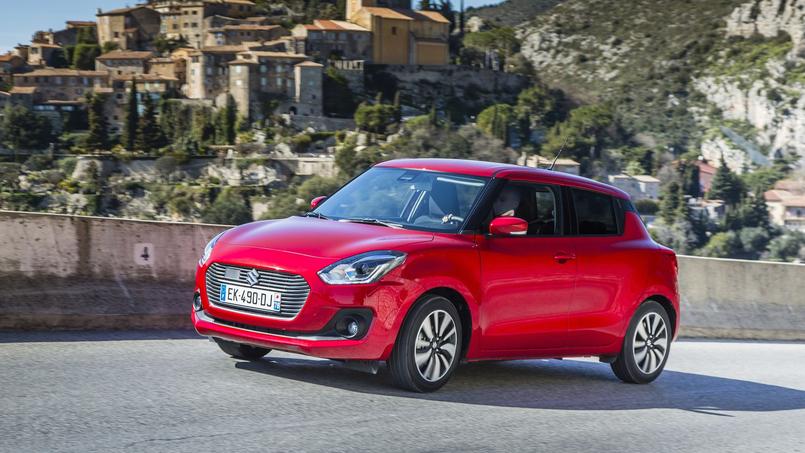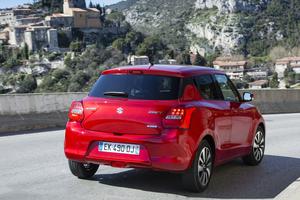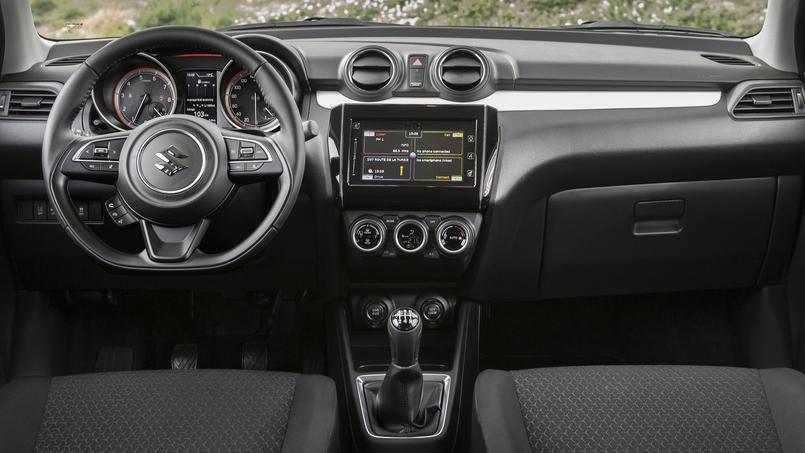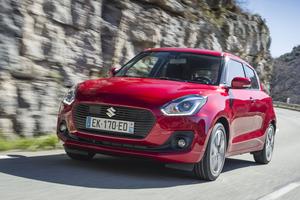Suzuki Swift, a small resourceful
The Suzuki Swift is not a model like any other. It allowed the Japanese specialist of small formats to emerge from the shadows and to change dimensions. Since 2005, nearly 5.4 million units have been distributed worldwide, including nearly 120,000 in France. Thanks to this model which enjoys a strong capital sympathy, the brand has doubled its commercial performance. In other words, the passage of witness to the new generation had to be done smoothly. The Japanese manufacturer has thus chosen the path of wisdom, endeavoring to erase the main defects of the preceding model.
The urbanist puts the forms
Neither quite the same, nor quite another, the new generation Swift remains easily identifiable. As the lines lose tension, the shoulders muscle, the grille widens giving the impression of a better car sitting on the road, the rear door handles now hidden in the uprights and the floating roof dropping like the d A coupé contribute to the dynamism of the silhouette. Suzuki has preserved the essentials, namely a compact gauge (3.84 m) facilitating life in the urban jungle and parking maneuvers. The wheelbase increases by 20 mm while the length is decreasing by 10 mm. The change of generation is also accompanied by a new platform that is more rigid and lighter. Far from being thin, the gain is exemplary: the Swift weight loss of 120 kilos, bringing the mass to 840 kilos with the 1.2 liter of 90 hp. This slimming cure generates a virtuous circle contributing to the reduction of the carbon footprint and driving dynamism. This filiform urbanist abandons the silhouette 3 doors but retains the two-tone versions that contributed to the success of the model.
A revolutionary space
It is by penetrating inside that the faithful of the Swift will perceive the deepest changes. The Suzuki Citadine succumbs to the decline in orders, adopting, from level 2, a 7-inch touchscreen combining all the features (GPS navigation, radio, smartphone pairing), with the exception of managed air conditioning By three rotary knobs and the volume of the radio controlled from the steering wheel. No doubt: Suzuki placed the driver at the center of the debate, seating it 21 mm lower than in the old model, pointing the central screen 5 degrees towards him and housing the two meters of the handset under oblong caps evoking Alfa Romeo. The perfect driving position is based on a steering wheel adjustable in height and depth and a large amplitude of seat adjustments. The rear occupancy is in the good average of the segment.
At the same time, the functionality has not been neglected. Known to be a tare of the previous model, the volume of the trunk now boasts 265 liters, a gain of 54 l obtained thanks to the suppression of the spare wheel. Finally, plastics are still not foamed, which is not really shocking at this level of range, but it is for the benefit of equipment. The upper Pack finish provides access to adaptive cruise control, automatic light management, line crossing alert, and precollision system coupled with automatic braking. The adjustment of this last one appeared to us too sensitive, especially when approaching an electronic toll barrier.
The joy of the hybrid
Not surprisingly, the engineers gave up diesel, which does not have to be on a city car. They developed a 3-cylinder direct injection petrol engine with a cylinder capacity of 998 cc. This 111 hp turbo engine can be combined with the light hybrid (Hybrid SHVS) already seen on the Ignis and based on an alterno-starter and a lithium-ion battery of 12 volts. The interest of this system is felt from the first meters. The contribution of the 50 Nm of torque of the electric generator is the effect of an invisible hand that pushes in the back. The result is an impression of vigor multiplied tenfold, the more so because you are often dispensed from lowering the reports, the 1 liter resuming at very low regimes without recoil and without jerks. The generator operates below 3,900 rpm, at less than 120 km / h and per 30-second session, with the battery recharging very quickly at deceleration and braking. It is above all at the pump that the system is well-founded. Suzuki boasts a 1 l / 100 km gain in the city. The computer indicated 5.2 l / 100 km at the end of our test, 0.9 l more (97 g / km of CO2) than the official data.
The very pleasant sensations that the joy of the engine makes go up are hindered by the improved guidance of the 5-speed manual transmission. At the wheel, there is one of the character traits of the Swift, an efficient chassis that makes it possible to wind the difficulties of a winding road with happiness. On the other hand, we must avoid damaged roadways, bleedings, and backsides where the Swift is undervalued. We would also have appreciated a direction gaining firmness as the speed increases. A typing that will perhaps be reserved for the Sport version programmed at the end of 2018 and probably equipped with the 1.4 l turbo gasoline of 140 ch already equipping the Vitara S. After the test of the pimpant 1 liter SHVS, the question of l Interest of the 1.2-liter 4-cylinder of 90 hp is laid. Its maintenance guarantees an access price close to 13,500 euros when the model of our test should be around 17,000 euros....
Our opinion: Suzuki has made it. Without renouncing, the Swift enters a modern era. We regret that the 1 liter version is not compatible with the 6-speed automatic transmission.
Technical sheet
Engine: 3-cylinder turbo gasoline, 998 cc
Power: 111 hp at 5,500 rpm
Torque: 170 Nm from 2000 to 3500 rpm
Transmission: 5-speed manual transmission
Weight: 875 kg
Dimensions: 3.840 / 1.735 / 1.495 mm
Safe: 265 dm3
Speed: 195 km / h
0 to 100 km / h: 10.6 s
Consumption: 4.3 l / 100 km
CO² Emissions: 97 g / km
Price: about 17 000 € in finish Pack





Komentar
Posting Komentar